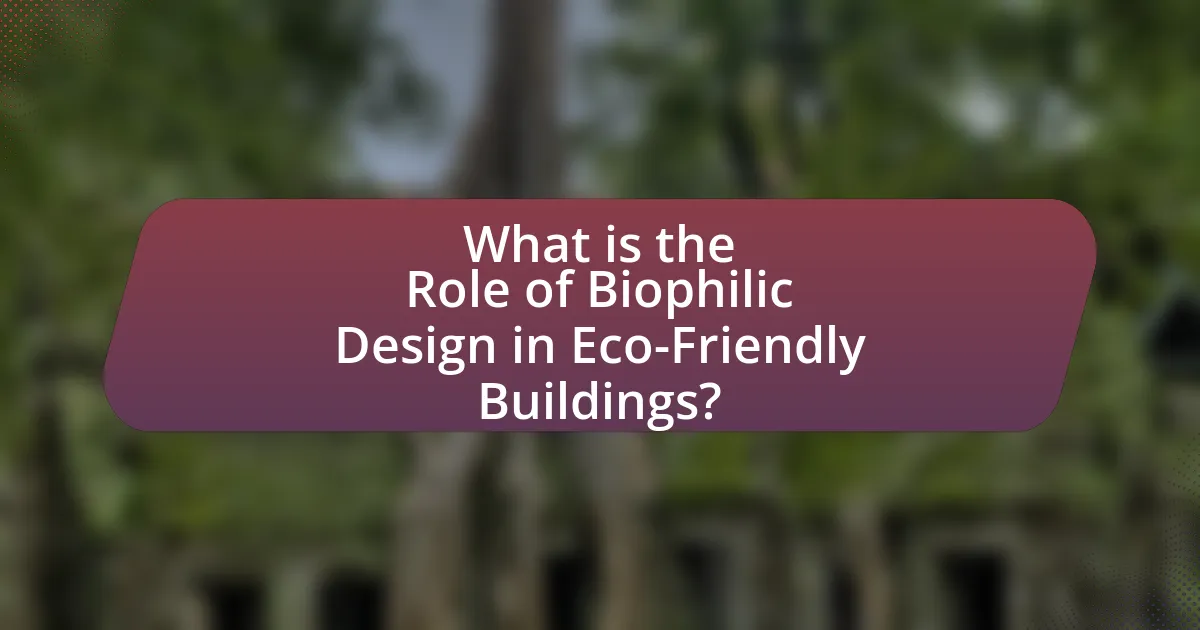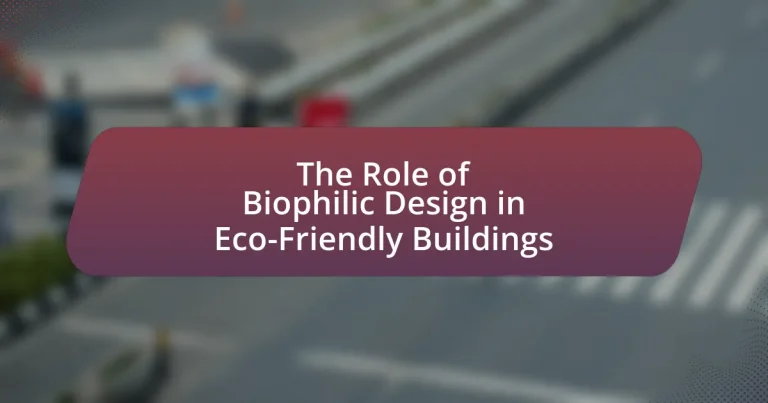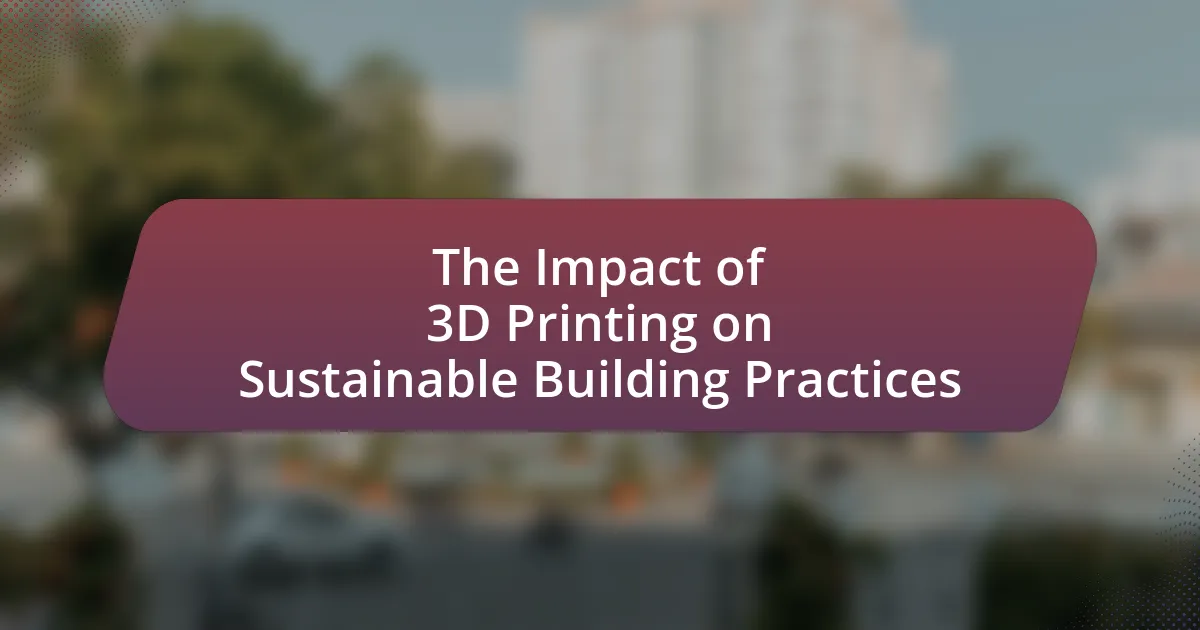Biophilic design is a crucial aspect of eco-friendly buildings, focusing on the integration of natural elements to enhance occupant well-being and promote sustainability. This design approach improves air quality, utilizes natural lighting, and incorporates sustainable materials, leading to reduced stress and increased productivity among occupants. Key principles include maximizing natural light, incorporating greenery, and fostering a connection to nature, which collectively contribute to energy efficiency and improved indoor environments. Despite challenges such as high initial costs and regulatory hurdles, biophilic design is evolving with advancements in sustainable materials and technology, emphasizing the importance of community engagement and best practices for successful implementation.

What is the Role of Biophilic Design in Eco-Friendly Buildings?
Biophilic design plays a crucial role in eco-friendly buildings by integrating natural elements into architectural spaces, which enhances occupant well-being and promotes sustainability. This design approach fosters a connection between people and nature, leading to improved air quality, natural lighting, and the use of sustainable materials. Research indicates that incorporating biophilic elements can reduce stress and increase productivity, with studies showing that exposure to nature can lower blood pressure and enhance mood. For instance, a study published in the Journal of Environmental Psychology found that individuals working in environments with biophilic design reported a 15% increase in overall well-being. Thus, biophilic design not only supports ecological goals but also contributes to healthier living and working environments.
How does biophilic design contribute to sustainability in architecture?
Biophilic design contributes to sustainability in architecture by integrating natural elements into built environments, which enhances energy efficiency and reduces resource consumption. This design approach promotes the use of natural light, ventilation, and materials, leading to lower energy demands and improved indoor air quality. Studies indicate that buildings incorporating biophilic elements can achieve up to 30% energy savings compared to conventional designs, as reported by the World Green Building Council. Additionally, biophilic design fosters biodiversity by incorporating green spaces, which can mitigate urban heat and improve stormwater management, further supporting sustainable practices in architecture.
What are the key principles of biophilic design?
The key principles of biophilic design include the incorporation of natural elements, the use of natural light, and the creation of spaces that promote a connection to nature. These principles aim to enhance human well-being and productivity by integrating nature into the built environment. For instance, studies have shown that access to natural light can improve mood and reduce stress, while the presence of plants and natural materials can enhance cognitive function and creativity.
How does biophilic design enhance the connection between humans and nature?
Biophilic design enhances the connection between humans and nature by integrating natural elements into built environments, fostering a sense of well-being and promoting psychological benefits. This design approach incorporates features such as natural light, vegetation, water elements, and organic materials, which have been shown to reduce stress and improve mood. Research by Kaplan and Kaplan (1989) indicates that exposure to nature can enhance cognitive function and emotional health, supporting the idea that biophilic design creates environments that resonate with human instincts and needs. Furthermore, a study published in the Journal of Environmental Psychology found that workplaces designed with biophilic principles led to a 15% increase in employee productivity and a 6% decrease in absenteeism, demonstrating the tangible benefits of connecting people with nature through design.
Why is biophilic design important for eco-friendly buildings?
Biophilic design is important for eco-friendly buildings because it enhances the connection between humans and nature, promoting well-being and sustainability. This design approach incorporates natural elements, such as light, vegetation, and water features, which can improve air quality and reduce energy consumption. Studies show that biophilic design can lead to a 15% increase in productivity and a 6% reduction in energy use, as reported in the “Impact of Biophilic Design on Building Performance” by the University of Oregon. By integrating these natural elements, eco-friendly buildings not only support environmental goals but also foster healthier living and working environments.
What impact does biophilic design have on occupant well-being?
Biophilic design significantly enhances occupant well-being by fostering a connection to nature, which has been shown to reduce stress and improve mental health. Research indicates that environments incorporating natural elements, such as plants, natural light, and water features, can lead to increased feelings of tranquility and satisfaction among occupants. For instance, a study published in the Journal of Environmental Psychology found that exposure to natural elements can lower cortisol levels, a marker of stress, and enhance overall mood. Additionally, biophilic design has been linked to improved cognitive function and productivity, as environments that mimic natural settings can enhance focus and creativity.
How does biophilic design influence energy efficiency in buildings?
Biophilic design enhances energy efficiency in buildings by integrating natural elements that improve thermal performance and reduce reliance on artificial lighting. For instance, the incorporation of natural ventilation and daylighting strategies can significantly lower energy consumption; studies show that buildings designed with biophilic principles can achieve up to 30% energy savings compared to conventional designs. Additionally, the use of vegetation in and around buildings can provide insulation, reducing heating and cooling demands. This evidence supports the assertion that biophilic design not only fosters a connection to nature but also contributes to sustainable energy practices in architecture.
What are the challenges of implementing biophilic design in eco-friendly buildings?
Implementing biophilic design in eco-friendly buildings faces several challenges, including high initial costs, design complexity, and regulatory hurdles. High initial costs arise from the need for specialized materials and technologies that integrate natural elements effectively. Design complexity is a challenge as architects and builders must balance aesthetic appeal with functionality, often requiring advanced skills and knowledge. Regulatory hurdles can impede the adoption of biophilic design, as existing building codes may not accommodate innovative features that promote natural integration. These challenges can hinder the widespread implementation of biophilic design in eco-friendly buildings, despite its benefits for occupant well-being and environmental sustainability.
What common misconceptions exist about biophilic design?
Common misconceptions about biophilic design include the belief that it solely involves the incorporation of plants into a space. In reality, biophilic design encompasses a broader range of elements, such as natural light, water features, and organic materials, all aimed at enhancing human well-being and connection to nature. Another misconception is that biophilic design is only relevant in outdoor settings; however, it can be effectively integrated into indoor environments to improve air quality and reduce stress. Additionally, some people think that biophilic design is a luxury rather than a necessity, but studies show that it can lead to increased productivity and reduced healthcare costs, making it economically beneficial.
How can architects overcome barriers to biophilic design integration?
Architects can overcome barriers to biophilic design integration by employing collaborative design processes that involve stakeholders early in the project. Engaging clients, engineers, and community members fosters a shared vision and addresses concerns about costs and feasibility. Research indicates that projects incorporating biophilic elements can enhance occupant well-being and productivity, leading to long-term economic benefits. For instance, a study by the University of Queensland found that biophilic design can increase productivity by up to 15%, demonstrating that initial investments can yield significant returns. By emphasizing these benefits and utilizing innovative materials and technologies, architects can effectively integrate biophilic design into their projects.
How can biophilic design be effectively integrated into building projects?
Biophilic design can be effectively integrated into building projects by incorporating natural elements, maximizing natural light, and creating green spaces. This approach enhances occupant well-being and productivity, as evidenced by studies showing that access to nature can reduce stress and improve cognitive function. For instance, a study published in the Journal of Environmental Psychology found that views of nature significantly enhance mood and attention. Additionally, using materials that reflect natural textures and colors can create a more inviting environment, further supporting the principles of biophilic design.
What strategies can be employed to incorporate natural elements in design?
To incorporate natural elements in design, strategies include using organic materials, maximizing natural light, and integrating greenery. Organic materials such as wood, stone, and bamboo create a connection to nature and enhance sustainability. Maximizing natural light through large windows or skylights reduces reliance on artificial lighting and improves occupant well-being. Integrating greenery, such as indoor plants or green walls, not only purifies the air but also fosters a calming environment. Research indicates that biophilic design can improve productivity and reduce stress, as evidenced by a study published in the Journal of Environmental Psychology, which found that exposure to natural elements significantly enhances mood and cognitive function.
How can technology support biophilic design in modern architecture?
Technology can support biophilic design in modern architecture by integrating natural elements through advanced building systems and materials. For instance, smart glass can adjust transparency to optimize natural light while reducing glare, enhancing occupants’ connection to the outdoors. Additionally, automated climate control systems can mimic natural ventilation patterns, improving indoor air quality and comfort. Research indicates that incorporating biophilic elements, such as living walls and natural lighting, can increase productivity and well-being by up to 15%, as shown in studies conducted by the University of Oregon. These technological advancements not only facilitate the integration of nature into built environments but also promote sustainability and energy efficiency, aligning with eco-friendly building practices.
What are the future trends in biophilic design for eco-friendly buildings?
Future trends in biophilic design for eco-friendly buildings include increased integration of natural elements, enhanced use of sustainable materials, and the incorporation of advanced technology for environmental monitoring. These trends reflect a growing recognition of the psychological and physical benefits of nature in built environments. For instance, studies show that incorporating greenery can reduce stress and improve productivity, leading to a demand for designs that feature living walls, green roofs, and natural ventilation systems. Additionally, the use of materials sourced from renewable resources is becoming more prevalent, aligning with sustainability goals. Furthermore, smart building technologies are being developed to optimize energy use and enhance occupant comfort, demonstrating a commitment to both ecological and human well-being.
How is biophilic design evolving with advancements in sustainable materials?
Biophilic design is evolving significantly due to advancements in sustainable materials, which enhance the integration of natural elements into built environments. Sustainable materials, such as reclaimed wood, bamboo, and recycled metals, not only reduce environmental impact but also promote a connection to nature, a core principle of biophilic design. For instance, the use of biocomposite materials that mimic natural textures and colors can create a more immersive experience, fostering well-being and productivity among occupants. Research indicates that environments incorporating biophilic elements can improve cognitive function and reduce stress, highlighting the importance of these advancements in creating healthier living spaces.
What role does community engagement play in the future of biophilic design?
Community engagement is crucial for the future of biophilic design as it fosters collaboration between designers, stakeholders, and the community, ensuring that spaces reflect the needs and values of those who use them. Engaging the community in the design process leads to more sustainable and meaningful environments, as evidenced by projects like the High Line in New York City, where community input significantly shaped the design and functionality of the space. This participatory approach not only enhances user satisfaction but also promotes stewardship of natural resources, aligning with the principles of biophilic design that emphasize a connection to nature and well-being.
What best practices should be followed for successful biophilic design implementation?
Successful biophilic design implementation requires integrating natural elements into built environments to enhance well-being and sustainability. Best practices include maximizing natural light through large windows and skylights, incorporating indoor plants and green walls, and using natural materials like wood and stone to create a connection with nature. Research indicates that environments enriched with biophilic elements can improve occupant health and productivity by up to 15%, as shown in a study by the University of Oregon. Additionally, designing spaces that provide views of nature and incorporating water features can further enhance the biophilic experience, leading to increased satisfaction and reduced stress among occupants.





